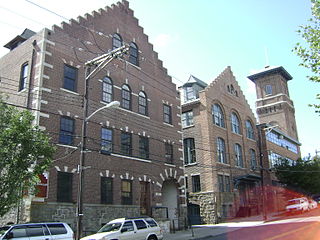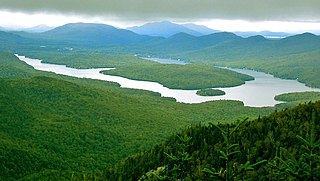
Johnson Wax Headquarters is the world headquarters and administration building of S. C. Johnson & Son in Racine, Wisconsin. Designed by American architect Frank Lloyd Wright for the company's president, Herbert F. "Hib" Johnson, the building was constructed from 1936 to 1939. Its distinctive "lily pad" columns and other innovations revived Wright's career at a point when he was losing influence. Also known as the Johnson Wax Administration Building, it and the nearby 14-story Johnson Wax Research Tower were designated as a National Historic Landmark in 1976 as Administration Building and Research Tower, S.C. Johnson and Son.

This list is intended to be a complete compilation of properties and districts listed on the National Register of Historic Places in Rensselaer County, New York, United States. Seven of the properties are further designated National Historic Landmarks.

Pullman National Monument, also known as The Pullman District and Pullman Historic District, is located in Chicago and was the first model, planned industrial community in the United States. The district is significant for its historical origins in the Pullman Company, one of the most famous company towns in the United States, and scene of the violent 1894 Pullman strike. It was built for George Pullman as a place to produce the famous Pullman sleeping cars.

The Moose Entrance Kiosk was built between 1934 and 1939 by either the Public Works Administration or the Civilian Conservation Corps at the entrance to Grand Teton National Park. The log kiosk was built to National Park Service standard plans in the National Park Service Rustic style. It was originally located near the park's former administrative area, but was moved in the early 1960s to the new administration center and entrance at Moose. It is the last survivor of that building type and era in the park.

The Southbridge-Sargent Manufacturing District encompasses a collection of three 19th-century factory buildings near a historically important railroad junction in southern Worcester, Massachusetts. They were built near the intersection of Sargent and Gold Streets, just south of Southbridge Street. The location is close to a junction of three major railroads: the Boston and Albany, the Norwich and Worcester, and the New York, New Haven, and Hartford. The area was once a major industrial part of the city, but has lost many of its historic factory buildings in the 20th century.

The Knickerbocker Building is an eclectic, Dutch Colonial Revival industrial building located at 50-52 Webster Avenue in the city of New Rochelle, Westchester County, New York.

The Corbin Building is a historic office building located at 13 John Street at the corner of Broadway – where it is numbered as 192 – in the Financial District of Manhattan, New York City. It was built in 1888-89 and was designed by Francis H. Kimball in the Romanesque Revival style with French Gothic detailing. The building was named for Austin Corbin, a president of the Long Island Rail Road who also founded several banks. It was built as a speculative venture for use as office space or housing.

There are 65 properties listed on the National Register of Historic Places in Albany, New York, United States. Six are additionally designated as National Historic Landmarks (NHLs), the most of any city in the state after New York City. Another 14 are historic districts, for which 20 of the listings are also contributing properties. Two properties, both buildings, that had been listed in the past but have since been demolished have been delisted; one building that is also no longer extant remains listed.

Welch Factory Building No. 1 is a historic grape juice factory located at Westfield in Chautauqua County, New York. It was built in 1897 and expanded in 1899 and 1903, to be an 8-bay wide, 10-bay deep rectangular building. It is the oldest extant structure associated with the Welch's company.

US Post Office-Endicott is an historic post office building located at Endicott in Broome County, New York. It was designed and built in 1936 and is one of a number of post offices in New York State designed by a consulting architect for the Office of the Supervising Architect of the Treasury Department, Walter Whitlack. It is a one-story, nine bay steel frame, cream-colored brick clad building on a raised granite-clad foundation executed in the Colonial Revival style. The interior features a 1938 mural titled "Excavating for the Ideal Factory" by Douglass Crockwell.

The American Chicle Company Building, built in 1911, is located in the Gert Town neighborhood of New Orleans, Louisiana.

The New York Belting and Packing Co. complex, also known locally for its main 20th-century occupant, the Fabric Fire Hose Company, is a historic industrial complex at 45-71, 79-89 Glen Road in Newtown, Connecticut. Its centerpiece is a four-story brick mill building with an Italianate tower, built in 1856. The property also includes a dam impounding the adjacent Pootatuck River, a mill pond, and a hydroelectric power generation facility. The site's industrial history begins about 1850, when the dam was built. The New York Belting and Packing Company built the present factory building and another further upstream, where it operated until 1917. The property was then acquired by a subsidiary of Uniroyal, which let the premises to the Fabric Fire Hose Company, its tenant until 1977.

Dolge Company Factory Complex, also known as Alfred Dolge and Sons Felt and Sounding Board Factories and Daniel Green Factory Complex, is a national historic district located at Dolgeville in Herkimer County, New York. The district contains 10 contributing buildings and one contributing structure. The complex includes a large limestone building built in 1886, a frame factory building, a double span Pratt truss bridge on limestone and concrete supports (1887), another large wood factory building, a complex of lesser buildings, and the Alfred Dolge mansion (1895). The limestone factory structure is a long feet, 3 1⁄2-story structure with a clerestory running the length of the roof ridge. It features a mansard roofed tower with dormers. The complex was built by Alfred Dolge (1848–1922), who desired to establish an ideal society for his factory workers. In the 1890s the complex was acquired by Daniel Green and William R. Green, who manufactured felt shoes and slippers. The mill is currently being used as an antique, second hand, and crafts shop.

Upper–Mill Street Historic District is a national historic district located at Poughkeepsie, Dutchess County, New York. It includes 25 contributing buildings built during the mid- to late-19th century. They include a variety of brick and frame buildings, originally residential, that have been converted to office and other commercial use. They are representative of vernacular mill workers' dwellings and fashionable factory owners' residences. The district also includes two churches.

C. Rieger's Sons Factory, also known as Arden Manufacturing Corporation and Piser Company, is a historic factory building located in the Mott Haven section of The Bronx, New York, New York. It was built in 1906, and is a six-story building clad in yellow iron spot brick in the Romanesque Revival style. The facade and windows are trimmed in bluestone. It originally housed a furniture manufacturer. It was converted for use as affordable housing during 2002-2003.

Hertlein and Schlatter Silk Trimmings Factory is a historic factory building located in the Mott Haven section of The Bronx, New York, New York. The original building was built in 1887 and expanded in 1892 and 1910-1911. It is a five-story brick building, 14 bays long. A six-story extension was built in 1904-1905. It originally housed a silk trimming supplier. After 1935, it housed the Hygrade Casket Corporation until about 1982. The original building and extension remained vacant until restored during 1999-2000 for residential and commercial use.

La Casina is a historic commercial building located in the Jamaica section of the New York City borough of Queens. It was originally built about 1907 and completely redesigned about 1936 in the Streamline Moderne style. It is one story building designed for use as a nightclub. It has a streamlined facade in the form of a stepped pyramid or ziggurat. The building retains its original vertical neon sign. From the 1940s through 1987, the building housed a clothing factory.

William B. Cronyn House, also known as the House at 271 Ninth Street, is a historic home in Park Slope, Brooklyn, New York, New York. It was built in 1856 and is a three-story Second Empire style dwelling with a slate covered mansard roof. The roof has ornamental iron cresting and a central half-story cupola with clerestory. In 1888, Charles M. Higgins (1854-1929) acquired the building to use as the Higgins American India Ink factory, and in 1899, added an extension to the factory at 240 Eighth Street. It was listed on the National Register of Historic Places in 1982.

The Clark Brothers Factory No. 1 was a historic industrial complex at 1331 South Main Street in the Milldale area of Southington, Connecticut. Developed beginning in the 1850s, it was one of the nation's largest sources of carriage bolts. The complex listed on the National Register of Historic Places in 1988 consisted of a group of brick buildings dating to 1893 and later. It has since been entirely demolished, and the land stands vacant and overgrown.

The Matthews and Willard Factory was a historic industrial site at Cherry Avenue and North Elm Street in Waterbury, Connecticut. Founded in 1874, Matthews and Willard contributed to the expansion of Waterbury's brass processing industry. The plant remained little altered from its last period of expansion c. 1900, and was a good example of period industrial architecture. It was listed on the National Register of Historic Places in 1988, and was demolished in 2012. As of 2018, the site stands vacant.


























